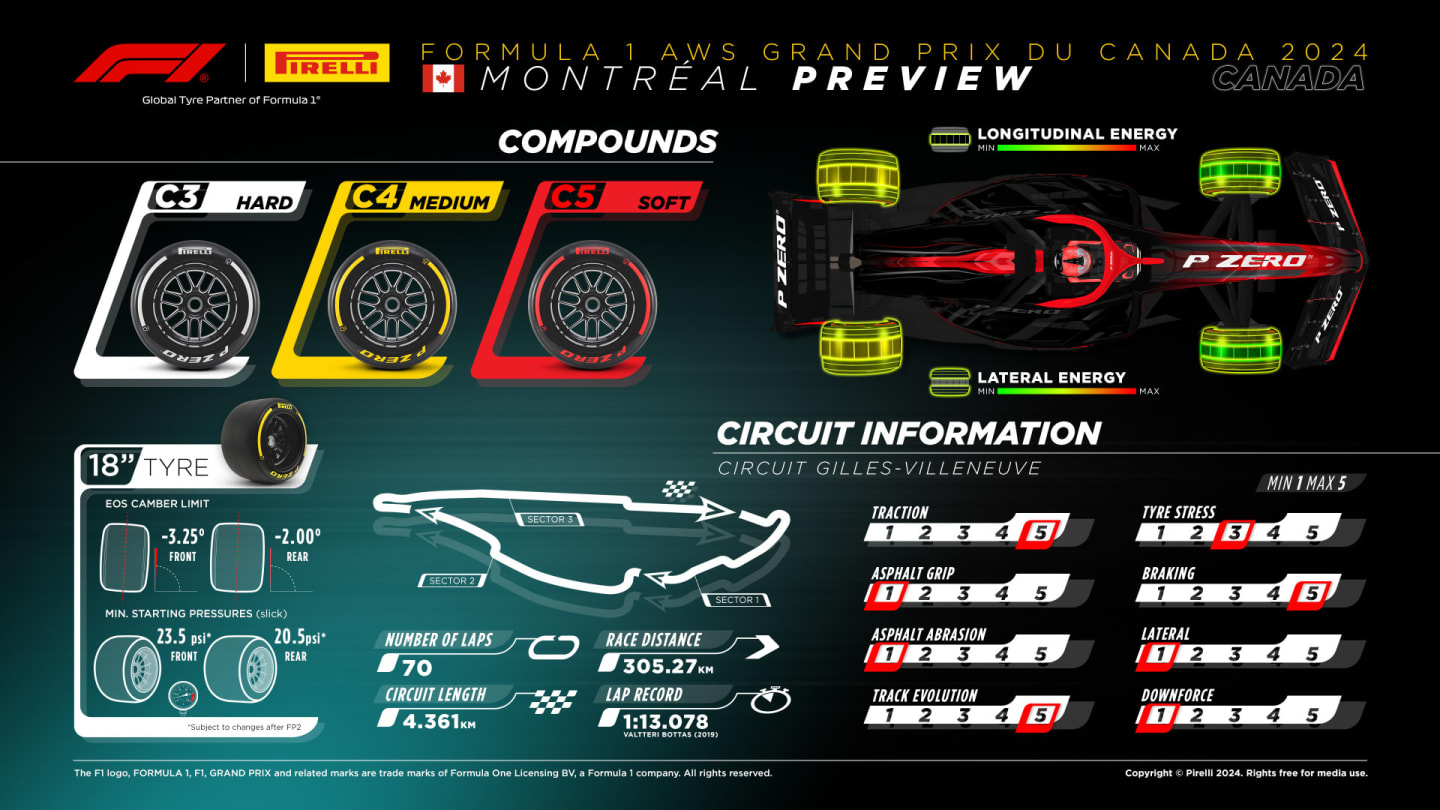As Formula 1 takes a detour from Europe to the iconic Circuit Gilles Villeneuve for the Canadian Grand Prix, Pirelli has unveiled the tyre compounds that will play a crucial role in this year’s race weekend.
Pirelli, the official tyre supplier for F1, is bringing the C3, C4, and C5 compounds to Montreal. These are the softest tyres in their range, already familiar to teams from their usage in Emilia Romagna and Monaco. This strategic choice by Pirelli emphasizes grip and flexibility, which can be game-changers on the newly resurfaced Canadian circuit.
Read More: 5 Storylines to Watch Ahead of the 2024 Canadian Grand Prix
Tyre Allocations for Teams
Drivers will be allocated two sets of the hard tyres (marked in white), three sets of the medium tyres (marked in yellow), and a generous eight sets of the soft tyres (marked in red). In addition, teams will have access to green intermediate tyres and blue full wets, ready to tackle any unpredictable weather conditions.
This allocation not only prepares drivers for different racing scenarios but also adds a layer of strategy to the game. Choosing the right moments to switch compounds could make or break their race weekend.
Track Transformations and Implications
This year brings notable changes to the Montreal track: it’s been completely resurfaced, and new kerbs have been installed. Pirelli’s weekend preview hints at the excitement and uncertainty surrounding these upgrades.
“The entire track has been resurfaced for this year and the kerbs have been replaced. On paper, the track’s existing characteristics of low abrasiveness and therefore reduced grip should remain the same, but the real indications will have to wait until the Pirelli engineers carry out their first measurement tests on Wednesday,” reads Pirelli’s statement.

The fresh surface means drivers might experience tire graining, especially on the softer compounds, and particularly on Friday. As cars lay down rubber and the track evolves, teams will need to adapt their strategies to manage wear and grip levels effectively.
Tire Performance and Race Strategy
With Montreal’s track being less demanding on tyres due to low lateral forces but higher longitudinal stress, it stands out as one of the more forgiving circuits of the F1 calendar in terms of tyre management. “For most of the year, the track is only used by people on foot or cyclists and so lap times generally drop significantly as the cars rubber-in the surface. Graining might also occur, especially on Friday and particularly with the softer compounds,” notes Pirelli.
Last year’s race brought all three dry compounds into action with varied strategies showcasing the versatility of options available. Drivers on the podium opted for a two-stop strategy, while some stretched the longevity of their tyres with minimal pit stops. The frequent appearance of the Safety Car adds another strategic layer, often rewarding those who extend their first stint and minimize time lost during pit stops.
Listen: F1 Nation Podcast Discusses Key Themes Ahead of Canadian GP
The Wildcard: Weather in Montreal
Montreal’s weather is notoriously unpredictable in June, further complicating strategy planning. Teams can face anything from cold, rainy, windy conditions to sunny and warm weather all in the span of one weekend—or even a single day. This ever-changing climate demands flexibility and quick adaptation from teams and drivers alike.
For more details on Pirelli’s F1 involvement and tyre technology, you can visit pirelli.com.
As the 2024 Canadian Grand Prix approaches, understanding these tyre dynamics will be essential for fans and teams. The choices made on pit lane could very well determine who stands atop the podium at Circuit Gilles Villeneuve.
